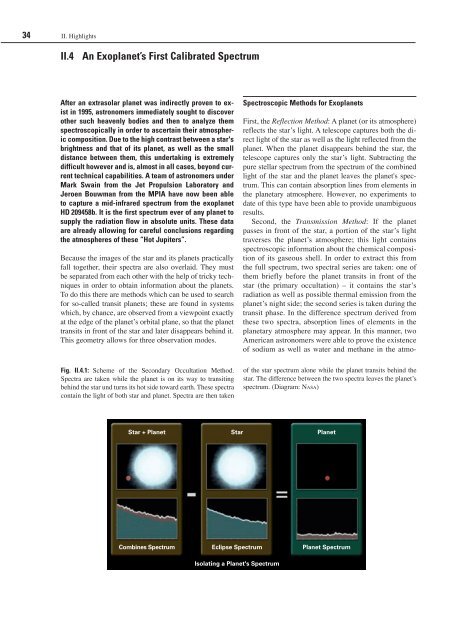Max Planck Institute for Astronomy - Annual Report 2007
Max Planck Institute for Astronomy - Annual Report 2007
Max Planck Institute for Astronomy - Annual Report 2007
You also want an ePaper? Increase the reach of your titles
YUMPU automatically turns print PDFs into web optimized ePapers that Google loves.
34 II. Highlights<br />
II.4 An Exoplanet’s First Calibrated Spectrum<br />
After an extrasolar planet was indirectly proven to exist<br />
in 1995, astronomers immediately sought to discover<br />
other such heavenly bodies and then to analyze them<br />
spectroscopically in order to ascertain their atmospheric<br />
composition. Due to the high contrast between a star's<br />
brightness and that of its planet, as well as the small<br />
distance between them, this undertaking is extremely<br />
difficult however and is, almost in all cases, beyond current<br />
technical capabilities. A team of astronomers under<br />
Mark Swain from the Jet Propulsion Laboratory and<br />
Jeroen Bouwman from the MPIA have now been able<br />
to capture a mid-infrared spectrum from the exoplanet<br />
HD 209458b. It is the first spectrum ever of any planet to<br />
supply the radiation flow in absolute units. These data<br />
are already allowing <strong>for</strong> careful conclusions regarding<br />
the atmospheres of these “Hot Jupiters”.<br />
Because the images of the star and its planets practically<br />
fall together, their spectra are also overlaid. They must<br />
be separated from each other with the help of tricky techniques<br />
in order to obtain in<strong>for</strong>mation about the planets.<br />
To do this there are methods which can be used to search<br />
<strong>for</strong> so-called transit planets; these are found in systems<br />
which, by chance, are observed from a viewpoint exactly<br />
at the edge of the planet’s orbital plane, so that the planet<br />
transits in front of the star and later disappears behind it.<br />
This geometry allows <strong>for</strong> three observation modes.<br />
Fig. II.4.1: Scheme of the Secondary Occultation Method.<br />
Spectra are taken while the planet is on its way to transiting<br />
behind the star und turns its hot side toward earth. These spectra<br />
contain the light of both star and planet. Spectra are then taken<br />
Star + Planet<br />
Combines Spectrum<br />
Star<br />
Eclipse Spectrum<br />
Isolating a Planet's Spectrum<br />
Spectroscopic Methods <strong>for</strong> Exoplanets<br />
First, the Reflection Method: A planet (or its atmosphere)<br />
reflects the star’s light. A telescope captures both the direct<br />
light of the star as well as the light reflected from the<br />
planet. When the planet disappears behind the star, the<br />
telescope captures only the star’s light. Subtracting the<br />
pure stellar spectrum from the spectrum of the combined<br />
light of the star and the planet leaves the planet's spectrum.<br />
This can contain absorption lines from elements in<br />
the planetary atmosphere. However, no experiments to<br />
date of this type have been able to provide unambiguous<br />
results.<br />
Second, the Transmission Method: If the planet<br />
passes in front of the star, a portion of the star’s light<br />
traverses the planet’s atmosphere; this light contains<br />
spectroscopic in<strong>for</strong>mation about the chemical composition<br />
of its gaseous shell. In order to extract this from<br />
the full spectrum, two spectral series are taken: one of<br />
them briefly be<strong>for</strong>e the planet transits in front of the<br />
star (the primary occultation) – it contains the star’s<br />
radiation as well as possible thermal emission from the<br />
planet’s night side; the second series is taken during the<br />
transit phase. In the difference spectrum derived from<br />
these two spectra, absorption lines of elements in the<br />
planetary atmosphere may appear. In this manner, two<br />
American astronomers were able to prove the existence<br />
of sodium as well as water and methane in the atmo-<br />
of the star spectrum alone while the planet transits behind the<br />
star. The difference between the two spectra leaves the planet’s<br />
spectrum. (Diagram: Na s a)<br />
Planet<br />
Planet Spectrum

















